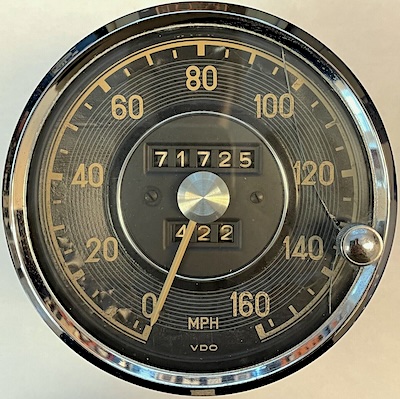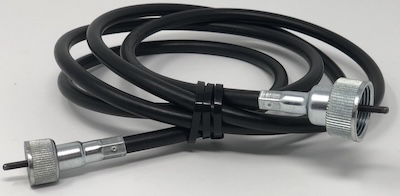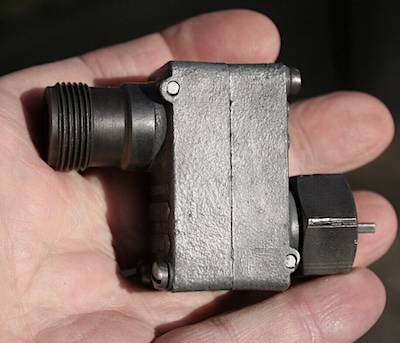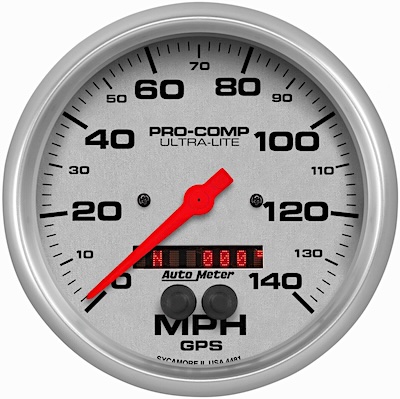Contents
Speedometer Types

Mercedes-Benz Gullwing speedometer
Manufacturers use different systems to show a vehicle’s speed, and several factors can impact the gauge’s accuracy.
Speedometers became common in vehicles in the early 1900s. After more than a century of refinement, the speedometers in cars today come in one of three types.
Cable-Driven Speedometer
Older cars use a cable connected to the car’s transmission. The cable’s rotation increases with the car’s speed. This end of the cable is connected to the output shaft of the transmission, so the speed of the wheels—not the speed of the engine—is transmitted to the speedometer.

Speedometer cable
The other end of the cable is attached to a magnet adjacent to the speedometer’s speed cup—a small aluminum cup attached to the shaft of the speedometer needle.
The magnet produces an electric field. As the magnet revolves faster, the current increases, which causes the cup to sweep the needle further on the gauge, thereby reflecting the faster rate.
Shop now for speedometer cablesElectronic Speed Sensors

Speed converter
Most modern cars use an electronic sensor, especially if they have a digital speed display. The sensor is a magnet near the car’s driveshaft. As the driveshaft revolves faster, the magnet sends a series of electronic pulses converted to a speed indication.
The magnet sweeps across a Hall-effect sensor, which detects and measures the voltage change caused by the magnetic field. The sensor communicates these readings to a computer, which converts the figures to numbers to display.
Some cars use an integrated antilock braking system (ABS) wheel sensor to provide the signal.
Along with the digital speed indication, some gauges still use an analog gauge to indicate the speed. However, in these modern systems, the moving needle is driven by the wheel sensors rather than a traditional cable.
GPS-Based Speedometer

AutoMeter Pro-Comp Ultra-Lite GPS speedometer
You occasionally find a vehicle that uses GPS to calculate speed. This is often a feature in modified older vehicles. The system constantly measures the differences in the distance over time, based on GPS signals, and calculates a speed. These systems may not operate in bad weather, in tunnels, or if the GPS signal is weak.
Shop now for GPS speedometersThe Number One Cause: Tire Size
Several factors can impact the accuracy speedometers. The primary factor that alters the accuracy of a speedometer is when you change the tire size. A bigger tire travels farther with one revolution of the wheel, and that slight difference in tire circumference quickly adds up. Even a small change in air pressure or when the tire wears down alters the tire’s circumference.
If you change the tire size on your vehicle, you should have the speedometer recalibrated. Mechanics can access the car’s computers and input the new tire size for an accurate speed reading. For cable-driven speedometers, shops can splice in a small gear adapter. The speedometer will then reflect a precise speed with the correct gears installed.
If you question the accuracy of a speedometer, there is an easy way to confirm the speed. On a quiet roadway, have a buddy drive adjacent to you at a steady speed. If the other car registers a speed that’s different from yours, your speedometer may have an issue. If you can’t find a clear enough stretch of road for this test, the map application on many phones will show you your speed while driving.
Troubleshooting a Speedometer
Determining the exact cause for an inaccurate speed reading depends on the type of system.
Cable-driven – If the needle or indicator on an analog speedometer moves sporadically, the cable may be wearing out or sticking within its sheath. Replacing the cable is an easy fix. You might notice a squeaking or grating noise if the cable is sticking within the sheath. If the speed cup is defective, the entire gauge usually needs to be replaced.
Electronic or GPS systems – These devices, although complex, rarely wear out. Typically, the check engine light illuminates, and a code indicates what is wrong. If the display does not show a speed, the sensor is likely broken, or the gauge cluster is bad. Replacing a speed sensor involves disconnecting the electrical connection and removing a few bolts. Replacing a gauge cluster is more involved because it is often difficult to access. Modern gauge clusters often require calibration which may be beyond the capabilities of a home mechanic.
Manufacturers recognize slight inconsistencies speedometer readings. A speedometer rarely shows a lower speed than the vehicle is actually traveling. For US commercial vehicles, the government limits the error to no more than five miles per hour at around 50 mph.
Shop now for speedometers




